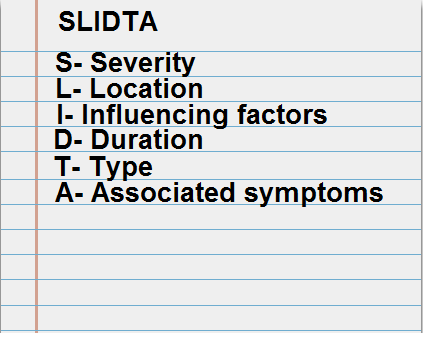SLIDTA

In this article, we go over the acronym SLIDTA.
SLIDTA is used when making health assessment of a patient.
Specifically, it is used when doing a focused assessment on a patient based on a health problem a patient is having.
A SOAP note is a health note that is written on a patient based on a health complaint that the patient is having.
One thing we do in a SOAP note is to write a history of the present illness (HPI). In this HPI, we want to include SLIDTA.
SLIDTA is an an acronym that stands for the following.
"S" stands for severity. The severity of the patient's pain is normally rated on a scale of 0 to 10 with 1 being very little pain and 10 being severe pain. You don't have to use a 1-10 pain scale rate, but you should use some pain scale to quantify the level of pain or discomfort the patient is in. An example of this is a patient complains of a pain of 8 out of 10 on a 1-10 pain scale rating.
"L" stands for location. Where is the pain or discomfort located? An example is the pain is in the right upper quadrant of the abdomen. It should be specific.
"I" stands influencing factors. In other words, what makes the pain worse and what makes the pain better. For example, a patient complains of abdominal pain that increases when coughing and gets better with 2 325mg tylenol tablets.
"D" stands for duration. How long has this patient been experiencing this pain? An example is the patient has had a sore throat for 6 days.
"T" stands for type. Describe the type of pain. Is the pain gnawing, aching, sharp...? An example is a patient having a sharp pain in the right upper quadrant.
"A" stands for associated symptoms. Besides the chief complaint, what other symptoms is the patient experiencing? An example is a patient has a chief complaint of a sore throat, but also has a mild headache and nasal congestion. The mild headache and nasal congestion are the associated symptoms.
So the SLIDTA acronym is included in the History of Present Illness of a SOAP note for a focused examination of a patient based on a chief complaint the patient is having.
Example of HPI: HPI: This is a 42-year-old caucasianwoman who complains of a sore throat has been present for the last 3 days. Reports that the pain gnawing and is localized to the tonsils and is a 9 out of 10 in severity. The pain is worse upon talking and swallowing. Using throat lozenges helps to soothe and ease the pain. Reports also a nausea and chills in the tonsil region. Denies any headaches.
Examining this HPI for SLIDTA, we see that the "S" is a 7 out of 10. The "L" is tonsils. The "I" is that the pain is worse upon talking and swallowing and that throat lozenges helps to make the pain better. The "D" stands for duration, which is 7 days. The "T" is a constant, sharp pain. The "A" is nausea and chills.
So this is how the SLIDTA acronym is important when doing health
assessments.
